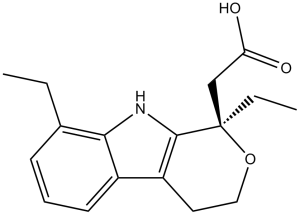Etodolac (AY-24236)
This product is for research use only, not for human use. We do not sell to patients.

For small sizes, please check our retail website as below: www.invivochem.com
| Size | Price | Stock |
|---|---|---|
| 10g | $520 | Check With Us |
| 25g | $850 | Check With Us |
| 50g | $1280 | Check With Us |
Cat #: V1052 CAS #: 41340-25-4 Purity ≥ 98%
Description: Etodolac (AY-24236, Etodolic Acid, AY24,236, AY24236, Lodine, Ramodar, Ultradol) is a potent nonsteroidal anti-inflammatory drug (NSAID) and a non-selective COX inhibitor with potential anti-inflammatory activity.
Top Publications Citing Invivochem Products
Publications Citing InvivoChem Products
Product Promise

- Physicochemical and Storage Information
- Protocol
- Related Biological Data
- Stock Solution Preparation
- Quality Control Documentation
| Molecular Weight (MW) | 287.35 |
|---|---|
| Molecular Formula | C17H21NO3 |
| CAS No. | 41340-25-4 |
| Storage | -20℃ for 3 years in powder formrr |
| -80℃ for 2 years in solvent | |
| Solubility In Vitro | DMSO: 58 mg/mL (201.8 mM)rr |
| Water: <1 mg/mLrr | |
| Ethanol: 58 mg/mL (201.8 mM) | |
| SMILES Code | O=C(O)CC1(CC)OCCC2=C1NC3=C2C=CC=C3CC |
| Synonyms | AY 24,236, Lodine, AY24,236, AY24236, Etodolic Acid, AY 24236, AY-24,236, AY-24236, Ramodar, Ultradol |
| Protocol | In Vitro | Post-marketing studies demonstrated that etodolac inhibition of cyclooxygenase is somewhat COX-2 selective similar to celecoxib and other "COX-2 inhibitors." Unlike rofecoxib, both etodolac and celecoxib can fully inhibit COX-1 and are designated as having "preferential selectivity" toward COX-2. The (inactive against COX) r-enantiomer of etodolac inhibits beta-catenin levels in hepatoma cells. |
|---|
These protocols are for reference only. InvivoChem does not
independently validate these methods.
| Solvent volume to be added | Mass (the weight of a compound) | |||
|---|---|---|---|---|
| Mother liquor concentration | 1mg | 5mg | 10mg | 20mg |
| 1mM | 3.4801 mL | 17.4004 mL | 34.8008 mL | 69.6015 mL |
| 5mM | 0.6960 mL | 3.4801 mL | 6.9602 mL | 13.9203 mL |
| 10mM | 0.3480 mL | 1.7400 mL | 3.4801 mL | 6.9602 mL |
| 20mM | 0.1740 mL | 0.8700 mL | 1.7400 mL | 3.4801 mL |
The molarity calculator equation
Mass(g) = Concentration(mol/L) × Volume(L) × Molecular Weight(g/mol)
Mass
=
Concentration
×
Volume
×
Molecular Weight*
The dilution calculator equation
Concentration(start)
×
Volume(start)
=
Concentration(final)
×
Volume(final)
This equation is commonly abbreviated as: C1 V1 = C2 V2
Concentration(start)
C1
×
Volume(start)
V1
=
Concentration(final)
C2
×
Volume(final)
V2
Step One: Enter information below
Dosage mg/kg
Average weight of animals g
Dosing volume per animal µL
Number of animals
Step Two: Enter the in vivo formulation
%DMSO
+
%
+
%Tween 80
+
%ddH2O
Calculation Results:
Working concentration:
mg/ml;
Method for preparing DMSO master liquid:
mg
drug pre-dissolved in
µL
DMSO(Master liquid concentration
mg/mL)
,Please contact us first if the concentration exceeds the DMSO solubility of the batch of drug.
Method for preparing in vivo formulation:
Take
µL
DMSO master liquid, next add
µL
PEG300, mix and clarify, next add
µL
Tween 80,mix and clarify, next add
µL
ddH2O,mix and clarify.
Note:
- (1) Please be sure that the solution is clear before the addition of next solvent. Dissolution methods like vortex, ultrasound or warming and heat may be used to aid dissolving.
- (2) Be sure to add the solvent(s) in order.




































